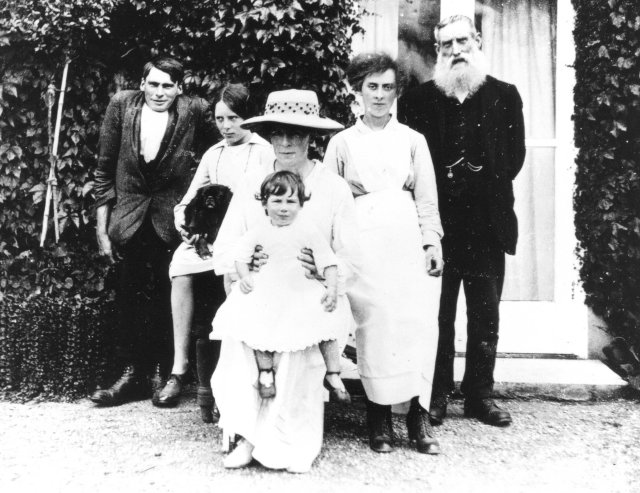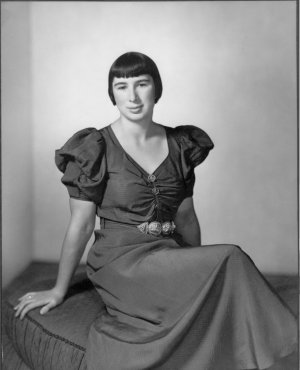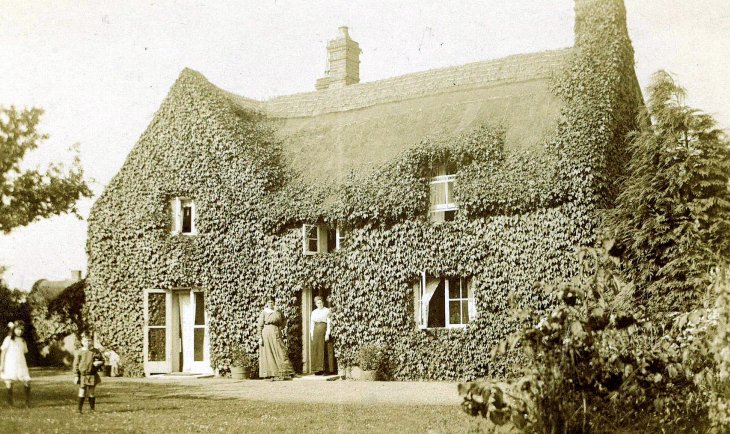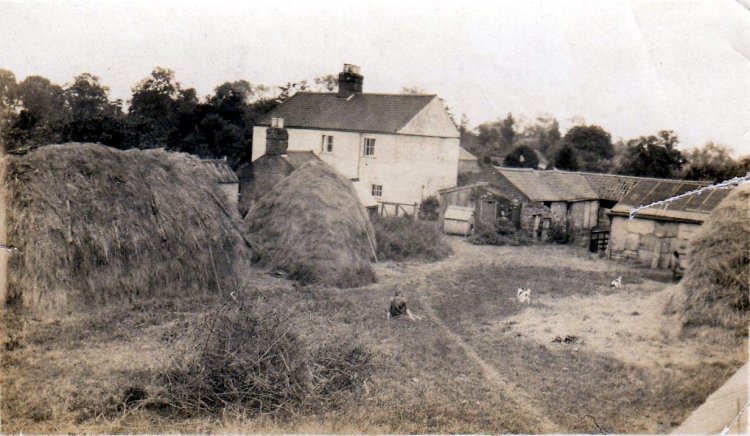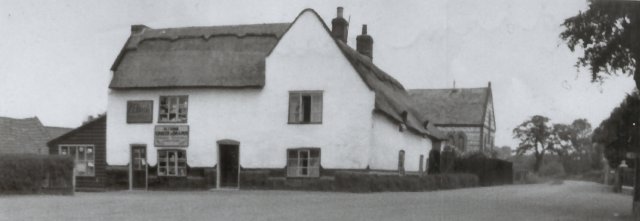

Staithe Road, Ludham remembered by
one of its oldest inhabitants.
As recalled by Nona Nivea Green (neé Dashwood-Howard)
As recalled by Nona Nivea Green (neé Dashwood-Howard)
This memory was written in 2000. In June 2019 when this was posted, Nona was still alive and over 100 years old and living in a nursing home in Hickling.
Nona Nivea Dashwood-Howard sitting on her mother's knee in 1922
Nona Nivea aged 18 - 19/12/1937
My parents came to live in Ludham in about 1925. (Note - we think this was actully about 1919) Before this, they had a holiday home in the village; their next door neighbour was a Miss Lamb. “The Mowle” was two cottages with gooseberry bushes in the front garden. On the other side of the road were two lovely old cottages (Tudor?) in which lived Mrs Rope and her daughter Miss Brunning. The latter went to South Africa in her youth with a family for whom she worked as a servant, from, I think, the age of eight. She brought me back an ostrich egg which I still have.
The Mowle. Home of the Dashwood-Howards in Ludham
We used to go to the farm every morning to get milk in a tin can. The milk was just poured into the can, never measured! The Bucks had the farm in those days. Mrs Rachel Buck was very house-proud; we were not allowed in the house until newspaper had been put on the floor! The lane at the side of the farm was Turner’s Lane, now called Lover’s Lane. Going towards the village on the left hand side there was a chapel; services were held there every Sunday and we used to hide in the hedge and listen to the groans and music coming through the chapel door, which for some reason was always left open. Beyond the chapel, there was a pigsty and other farm buildings also a cottage which was a two up and two down in which Mr and Mrs Mileham lived, her husband older by many years. She gave up keeping pigs and took in lodgers instead; she also kept chickens and we used to get our eggs from her, for, I think, one shilling a score. They were never sold by the dozen! Mrs Mileham’s cottage and the one next door to it were built by the Rice family. I think Miss Rice was Mrs Mileham’s sister and they lived next door to each other until Miss Rice married and went to live in Yarmouth. Rice cottages are still standing today.
Rear of Rice Cottages with the pigstys to the right.
On the other side of the road was Staithe House, the Doctor’s house. Dr Brown practised there in those days; he was very popular in the village. Staithe House was so called as the staithe was next to it and the wherries used to come up there to collect their cargo, but the retired doctor living in the Manor had great sway and put a stop to the wherries coming up because they damaged his land which was on the other side of the staithe. So the wherries used Womack instead, but I am glad to say this road is now officially called Staithe Road, greatly to the surprise of visitors.
Nearer to the village there was a tiny thatched cottage surrounded by flowers of all sorts. Mrs Hicks lived there; she was always dressed in black with a shawl over her head and shoulders. I thought she was a witch and I was terrified of her!
Further up the road towards the village there was a row of old cottages. Miss Brunning moved into one after her mother died. Hers was a one up, one down. In the cottage nearest to the village, lived a shoemaker and his wife. They used to repair our shoes. Mr Tidman was his name. Then there was a group of houses, they still remain. Mrs Watson lived in one. She used to do all our laundry. There was no non-iron fabric then. She took the washing one week and brought it back the next all beautifully ironed and aired. Her Christian name was Pamela but the locals called her Pemly. After this came Mrs Clark’s sweet shop. Clarkie as she was known by us children. She was a great pal of ours. We used to buy a ha’p’th of aniseed balls and she always put one or two extra sweets in the bag. She used to fold the paper to make the bags too. She also had extra, extra strong cough sweets which were kept in large green tins. We were not allowed to have them! Mrs Clark’s husband was a painter and decorator and worked for the firm of Dale, Riches and Clark. They had two children, a boy and a girl.
There were some sheds where Charlie Clark used to keep his paint etc, and another house between the Clark’s shop and the Post Office. George and Helen Thrower ran the Post Office. On the other side of the road, Harry Grapes had a Fish and Chip shop, now reverted to a private house again. He turned it into a shop after his mother died. It was a row of cottages. We were not supposed to buy fish and chips from there as mother considered them not very good. However, we did manage to smuggle a bag of chips in now and again! Needless to say, they tasted better than any others before or since!
The Post Office
Harry Grapes' Chip Shop
On the same side as Harry’s shop was Powell’s Grocery shop. There was great rivalry between the Powell’s shop and “Pop” Thrower’s store on the other side of Potter Road. The Powells had two very pretty daughters. Poor Mrs Powell was killed by machine gun fire in the village in the second World War. There was a coal merchant’s yard at the side of Powell’s shop. It was owned by Ebenezer Newton, Nick-named “Sneezer”. He had two sons, Arthur and Eddie. Arthur used to collect passengers from Wroxham station in a horse and cart first and then in a Model T Ford which was even more unreliable than the horse and cart! The car was tied together with bits of string in places and in the end it just fell apart, greatly to the relief of all who travelled with Arthur. He had to get a new car - a second hand one needless to say!
Powell's Stores
The Thrower’s Shop was owned by “Pop” Thrower, who was the grandfather of Tom who owns the shop now. He used to rule the family with a rod of iron and no-one was allowed to carve the ham if for some reason he was not in the shop; we had to wait until he returned. Beyond Thrower’s was England’s, the butchers shop. Mrs England was a real dragon! Woe betide anyone who complained about the meat if she served you. They had one daughter, Millie by name. She used to sing in the village concerts. Poor Millie used to be tied to the bedpost if she misbehaved when she was a child.
There were more thatched cottages, a whole row of them, where the new houses are now and at the end of the village was Cook’s shop, another nice thatched building, which fortunately is still standing but is not now a shop.
Cook's Stores
There was a bus service from Norwich to Yarmouth. It stopped at Ludham about every 2 hours in the winter and every hour in the summer. That has not changed much! I remember one winter. I think I must have been about 8 years old; there was a very heavy fall of snow. We walked to the village with great difficulty and the snow on the road was above my top boots - no road clearing in those days, needless to say!
In one of the cottages on the Potter Road lived Harriet Beevor. She had a brother Jack who used to sell oranges during the week and newspapers on Sundays. He walked to Yarmouth (some 13 miles) to get the oranges, then did a house-to-house round with them. He always picked out the blood oranges for us children as he thought they were the best. Harriet wrote me long letters after I was married. She had beautiful, old-fashioned writing, but her letters were difficult to read as she never used a full stop! I bought a corner what-not from her for which I paid two shillings and sixpence, my weekly pocket money in those days. Sam Knights was the saddler of the village. He was a fine saddler. His son Albert took over the shop after Sam died. Albert rather liked his drop and sang “Old Macdonald’s Farm” when he was merry. He also had a Rolls-Royce but had a mishap with it and was not allowed to drive any more. He kept it in front of the shop for years, and then had to move it as it took up too much room in the village. It ended up in the chicken run.
Albert Knights' Shop
Albert sold just about everything to do with farming and repairs that were available in those days. He had heaps of nails and screws all over the floor of his shop and he knew where everything was. Albert never sent a bill unless asked to do so. His reply was “Well you do not owe it to me until I send you the bill” He must have lost thousands of pounds!
Christmas was a lovely time then. There were always lots of carol-singers and, best of all, the handbell ringers. I think they came on Christmas Eve. They all stood round in the drawing room ringing the changes. The noise was deafening and every now and then the leader would shout “Up!” There was Loney who was the last of the millwrights, pork butcher Thrower, and Fred Kemp - he was the road-mender and was rather looked down upon by the other bell-ringers as he was the new boy! They were warmed to their bell ringing by whisky and mince-pies!
More Information.
There is more about the Dashwood-Howards here.
For the Rice and Mileham Familes click here.
For more about Ludham Shops click here.
For more about the Powells click here.
